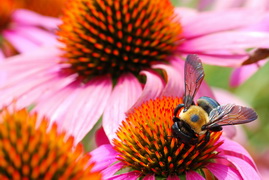
Development of New Tool to Estimate GM Pollen Spread
April 12, 2017| |
 An international study led by the University of British Columbia (UBC) evaluated the spread of genetically modified (GM) organisms to non-modified crops to figure out how far GM pollen travels, and develop accurate tools to estimate it.
An international study led by the University of British Columbia (UBC) evaluated the spread of genetically modified (GM) organisms to non-modified crops to figure out how far GM pollen travels, and develop accurate tools to estimate it.
Together with colleagues from the Université Catholique de Louvain (Belgium) and Delft University (The Netherlands), Rebecca Tyson, study co-author and associate professor of mathematics at UBC Okanagan developed a mathematical model of pollen dispersal by bees, based on field experiments. Tyson said that their study suggests that separation distances of several hundred meters, proposed by some European countries, is unnecessarily large, but separation by 40 meters is not sufficient.
Tyson adds that their model calculates separation sizes with better accuracy. For example, they estimate that for a 0.9 per cent cross-pollination rate, the ideal distance of separation between two crops is between 51 and 88 meters, depending on crop size and type. These numbers are specific to particular crops and landscapes, she explains, but the predictive ability is the same.
For more details, read the news article at UBC Okanagan News.
| |
Biotech Updates is a weekly newsletter of ISAAA, a not-for-profit organization. It is distributed for free to over 22,000 subscribers worldwide to inform them about the key developments in biosciences, especially in biotechnology. Your support will help us in our mission to feed the world with knowledge. You can help by donating as little as $10.
-
See more articles:
-
News from Around the World
- 108 Million People Face Severe Acute Food Insecurity – Report
- Development of New Tool to Estimate GM Pollen Spread
- Untangling Molecular Mechanisms Connecting Plant Stress and Growth
- Scientists Aim to Develop Crops that Require Less Labor
- Study Shows Natural Genetic Engineering in Grafted Plants
- New Biosafety Guidelines Introduced to Stakeholders in Cebu, Philippines
- EFSA Publishes Scientific Opinion on Three-Event Stack Oilseed Rape by Monsanto and Bayer
-
Research Highlights
- Identification of Gene Associated with Cold Tolerance at the Seedling Stage in Rice
- Mutant Rice Plants with Low Gibberellin Produce High Yield and Stress Tolerance
-
Beyond Crop Biotech
- Gene Mutation Found in ‘Night Owls'
- Genes that Give Cannabis its Flavor
-
Announcements
- 14th Annual BIO World Congress on Industrial Biotechnology
- March for Science
-
Resources
- The Petri Dish is Now Online
-
Plant
- Review of the Impacts of Genome Editing Techniques in Plants
-
Read the latest: - Biotech Updates (December 17, 2025)
- Gene Editing Supplement (December 17, 2025)
- Gene Drive Supplement (February 22, 2023)
-
Subscribe to BU: - Share
- Tweet
